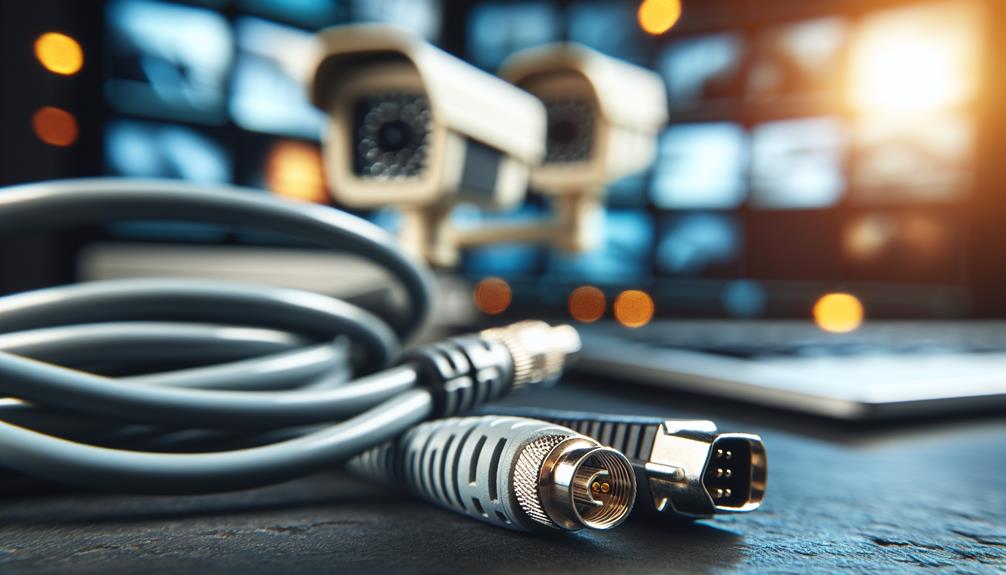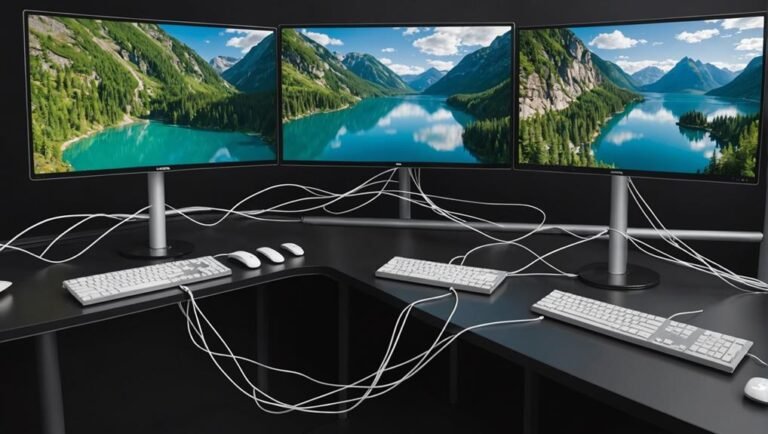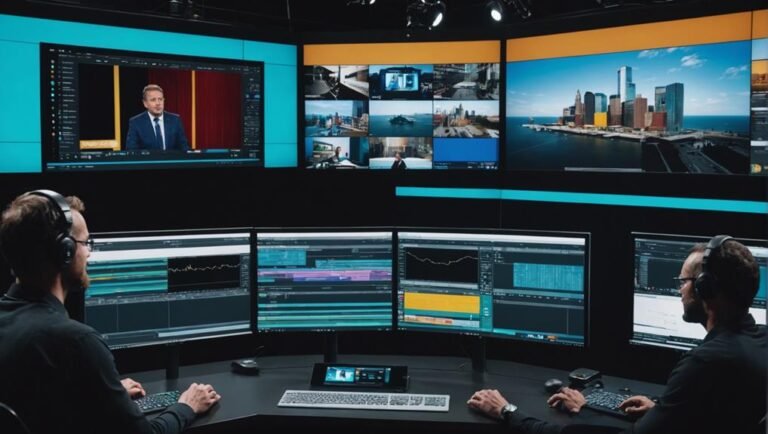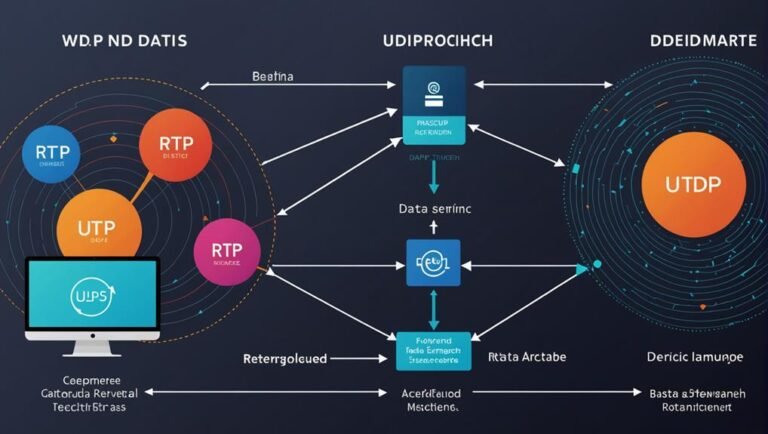Choosing the right cable for your CCTV system affects performance and reliability. Coaxial cables are dependable for analog cameras, offering minimal signal loss and simple installation. Cat6 cables excel in IP-based systems with higher data rates, supporting HD and 4K surveillance. They’re less prone to interference and better over long distances but require more planning and extra hardware. Coaxial cables are generally cheaper and easier to set up, while Cat6 is future-proof and increasingly common. Weighing your current needs and future scalability will help you make the best choice. To find out which suits your system best, stick around.
Coaxial Cable Overview
Coaxial cable, often used for traditional analog CCTV systems, provides a straightforward and reliable connection for video signals. You’ll appreciate its simplicity and proven track record. With a central core conductor, dielectric insulation, and a protective outer shield, coaxial cable guarantees minimal signal loss and interference, giving you peace of mind that your security footage remains clear and uninterrupted.
You won’t need to worry about complex setups or configurations. Coaxial cables are plug-and-play, making installation a breeze even if you’re not a tech guru. They’re also durable and can withstand various environmental conditions, so you can set up your CCTV system wherever you need without fretting over cable damage.
When it comes to distance, coaxial cables handle longer runs without significant signal degradation. This means you can cover larger areas without the hassle of signal boosters or repeaters. Plus, with their wide availability and cost-effectiveness, you won’t break the bank outfitting your entire property with a reliable surveillance system.
Ultimately, if you’re seeking a no-nonsense, dependable option for your security needs, coaxial cable offers a solid, time-tested solution that grants you both freedom and confidence.
Cat6 Cable Overview
Switching gears to modern advancements, Cat6 cable emerges as a popular choice for IP-based CCTV systems, offering higher data transmission speeds and enhanced performance. If you’re looking for a solution that keeps up with the demands of today’s high-definition video, Cat6 is your go-to. This cable type supports data rates up to 10 Gbps over shorter distances, guaranteeing that your surveillance footage is clear and lag-free.
Unlike older technologies, Cat6 cables are designed to reduce crosstalk and interference, giving you a cleaner signal. This makes them ideal for environments where multiple devices are operating simultaneously. Plus, they’re backward compatible with older Ethernet standards, so you won’t have to overhaul your entire network to upgrade.
Installing Cat6 is straightforward, offering flexibility regarding length and configuration. Whether you’re covering a small office or a sprawling campus, you can customize your setup to fit your specific needs. Even better, Cat6 cables can be used for both data and power transmission when paired with Power over Ethernet (PoE) technology, simplifying your cabling requirements.
Embrace the freedom and reliability that come with Cat6 cables, and guarantee your CCTV system is future-proofed.
Performance Comparison
When comparing the performance of Cat6 and coaxial cables for CCTV systems, you’ll notice significant differences in data transmission speed and signal quality. Cat6 cables are designed for high-speed data transfer, boasting speeds up to 10 Gbps over short distances. This makes Cat6 ideal for HD and 4K video surveillance, ensuring crisp and clear footage. In contrast, coaxial cables typically support lower data rates, which might suffice for standard definition cameras but struggle with higher resolutions.
Cat6 cables also offer superior signal integrity over long distances, reducing the need for signal boosters or repeaters. Coaxial cables, while robust, are more susceptible to signal degradation, especially over extended lengths. This can lead to poor image quality and potential signal loss, which isn’t what you want when security is on the line.
Here’s a quick comparison:
| Feature | Cat6 Cable | Coaxial Cable |
|---|---|---|
| Data Transmission Speed | Up to 10 Gbps | Up to 1 Gbps |
| Signal Quality | High (suitable for HD/4K) | Moderate (best for SD) |
| Distance Performance | Excellent | Moderate (requires boosters) |
| Susceptibility to Interference | Low | High |
Opting for Cat6 gives you the freedom to expand and upgrade your CCTV system without compromising performance.
Installation Differences
Installing Cat6 and coaxial cables for CCTV systems involves distinct processes that can impact the overall ease and cost of your setup. When it comes to coaxial cables, they’re generally simpler to work with if you’re dealing with analog cameras. You’ll only need a single cable for both video and power, which can streamline the installation.
On the other hand, Cat6 cables are typically used for IP cameras, offering more flexibility and future-proofing. However, they require more planning and additional hardware like network switches and potentially Power over Ethernet (PoE) injectors.
Here’s a breakdown of the installation differences:
- Coaxial Cables: These are easier to install if you’re using analog systems. It’s a single run for both video and power, making it straightforward but less adaptable for future upgrades.
- Cat6 Cables: These offer greater flexibility and are designed for IP systems. They require planning for network infrastructure, including switches and PoE injectors, but are more scalable.
- Distance Limitations: Coaxial cables can transmit signals up to 500 meters without significant loss, while Cat6 cables are limited to 100 meters without additional hardware.
- Interference: Cat6 cables are less prone to electromagnetic interference compared to coaxial, which makes them ideal for complex environments.
Cost and Availability
Choosing between coaxial cables and Cat6 for your CCTV system involves considering both cost and availability, as these factors can greatly impact your decision. Coaxial cables generally come in at a lower price point, making them a popular choice for those on a tighter budget. However, Cat6 cables, though slightly more expensive, offer greater future-proofing due to their higher data transmission capabilities.
When it comes to availability, coaxial cables have been around longer and are still widely accessible, especially in stores specializing in older tech. On the other hand, Cat6 cables are increasingly available, reflecting the growing trend towards modern, high-speed data networks.
Here’s a quick comparison to help you weigh your options:
| Aspect | Coaxial Cable | Cat6 Cable |
|---|---|---|
| Cost | Lower | Higher |
| Availability | Widely available | Increasingly common |
| Future-Proof | Limited | High |
Ultimately, your choice will depend on balancing your current budget with your need for future scalability. Embrace the freedom to choose what works best for your unique situation, but remember that slight extra investment in Cat6 might pay off in the long run.
Frequently Asked Questions
Can Coaxial Cables and Cat6 Cables Be Used Together in the Same CCTV System?
Yes, you can use both coaxial and Cat6 cables together in the same CCTV system. It gives you the flexibility to mix traditional and modern setups, ensuring you’re not limited by one type of technology.
How Do Weather Conditions Affect the Durability of Coaxial and Cat6 Cables?
Weather conditions impact both coaxial and Cat6 cables differently. Rain can corrode coaxial, reducing signal quality. Extreme temperatures can weaken Cat6, causing data loss. To guarantee durability, choose weather-resistant options and proper installation techniques.
Are There Specific Brands of Coaxial or Cat6 Cables Recommended for CCTV Applications?
You’ll find that brands like Belden, Commscope, and Monoprice offer reliable coaxial and Cat6 cables for CCTV. They’ve got a reputation for quality and durability, ensuring your surveillance system stays up and running smoothly.
What Are the Maintenance Requirements for Coaxial Versus Cat6 Cables in a CCTV Setup?
For maintenance, you’ll need to regularly check coaxial cables for signal degradation and wear, while Cat6 cables require you to confirm connections remain secure and free from interference. Both need occasional inspections to maintain peak performance.
Do Coaxial or Cat6 Cables Offer Better Resistance to Interference in Urban Environments?
You’re curious about interference resistance in urban settings, right? Cat6 cables typically offer better resistance to interference because they’re designed for high-speed data. So, for a cleaner signal in the city, go with Cat6.



